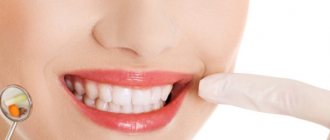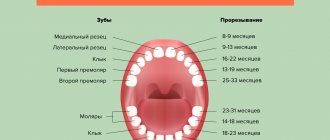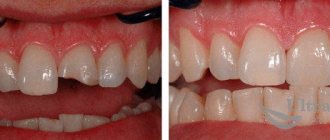Pediatric dentistry can be considered a separate section of modern dental practice, because due to the structural features, the treatment of baby teeth is somewhat different from the treatment of permanent teeth. Unfortunately, many parents are still convinced that baby teeth do not need dental care - after all, they will soon break down and fall out anyway. Therefore, children are not taken to the dentist very often, and if they are taken to the doctor, it is with advanced diseases and multiple problems.
In fact, dental treatment should be carried out at any age, and the sooner you consult a doctor with a problem, the higher the likelihood of getting rid of it quickly and without any complications. If a child has bad baby teeth, this will inevitably affect the health of his permanent ones - this is what parents need to remember when they want to “pity” the baby and not take him to an appointment with the “evil dentist.”
Gum inflammation
The most common inflammatory gum diseases in children are stomatitis and gingivitis. Stomatitis, or, as it is usually called, thrush, is an infectious inflammatory process provoked by fungi of the genus Candida. Treatment is antifungal and anti-inflammatory therapy, always carried out under the supervision and recommendations of a dentist. Self-medication can be dangerous, as some children may have allergic reactions to certain medications or antiseptics.
Gingivitis most often occurs due to plaque on baby teeth and insufficient general hygiene, but the reasons for their development can also be trauma to the gums during teething or other injuries, untreated caries. With this problem, you also need to contact a doctor, who will select the optimal treatment regimen and prevent gingivitis from developing into childhood periodontitis.
Indirect method
The indirect restoration method involves attaching special thin overlays to the front part of the dentition: veneers or lumineers. At the same time, there is no need for the final polishing stage, because the linings already have a perfectly smooth surface. Fixing veneers involves preliminary grinding; when installing lumineers, this is not necessary, since they are thinner.
Unfortunately, this method has a number of contraindications. These include serious bite pathologies and severe curvature of the dentition, which cannot be avoided without the installation of orthodontic structures. In addition, veneers cannot be fixed if there is significant tooth decay, when the coronal part is damaged by more than 50%.
Another important point: the installation of veneers is contraindicated for people prone to teeth grinding. This disease is called bruxism. Also, this method of restoration is not suitable for those who have a predisposition to severe tooth abrasion, as well as those who have bad habits (biting threads, excessive consumption of seeds, opening bottles with teeth, etc.) Contraindications also include playing certain sports, for example , boxing.
Caries, pulpitis and periodontitis of primary teeth in children
Milk teeth have thinner enamel and dentin layers than permanent teeth, they have a larger pulp chamber and, therefore, infection spreads faster to the pulp. They are more often susceptible to carious lesions - and not least because of night feeding or the habit of drinking drinks from a bottle at night (mostly sweet or sweetened - tea, juices).
In addition, caries is often provoked by plaque on baby teeth, which forms faster than in adults, and which not all parents are in a hurry to remove. Many people begin brushing their children’s teeth at a more or less conscious age, while a child should be taught hygiene and regularly remove plaque from the moment the first teeth erupt, that is, from about six months of age. Also, the cause of diseases of the dental system can be an insufficient amount of solid food in the baby’s diet, since chewing solid food helps to clean the dental surfaces themselves.
The child's nutritional habits, lack of hygiene, and too thin enamel layer provoke a phenomenon called circular caries of baby teeth - carious lesions spread over the entire tooth surface, as if encircling the crown.
Caries quickly turns into pulpitis - an inflammatory lesion of the dental pulp. Most often, a doctor is consulted precisely at this stage of the infectious process, ignoring the initial stages of damage to dental tissues. Pulpitis, in turn, provokes periodontitis of primary teeth in children - inflammation of the periodontal tissues near the tips of the tooth roots. This condition is usually accompanied by severe pain, severe swelling of the affected area, and often an increase in body temperature.
Features of the procedure
The anterior teeth do not experience as much chewing pressure as the chewing units. This is why the strength of the materials used may be lower. The aesthetic aspect is much more important, because the main task of restoration is to restore the attractiveness of the frontal area of the smile. Metal crowns are not used for these purposes, which eliminates the need for heavy grinding.
Minor defects, such as cracks, dark spots or slight curvature, can be restored using special composite materials. Dentists also often use special onlays for teeth, which have a minimum thickness and are not noticeable even upon closer examination. To install veneers, you must first grind the front side of the tooth. An alternative is restoration with lumineers, which does not require grinding.
The main indications for the procedure are such minor defects as the presence of a gap between the teeth, small curvatures, chips, a tendency to increased abrasion, etc. Of course, the main task of restoration is to restore an attractive appearance. However, we should not forget that returning the functional properties of teeth is also important.
Treatment of baby teeth
At the initial stages, caries is treated without tissue preparation - remineralization of the enamel, as well as modern Icon technology, which allows filling without drilling, easily cope with carious lesions of the enamel layer. In later stages, when the dentinal layer is affected, as well as in the case of pulpitis and periodontitis, treatment of baby teeth with tissue preparation will be required. You should not be afraid of such procedures - modern methods of anesthesia allow them to be carried out completely painlessly and comfortably for a small patient. In addition, the anesthetics used are harmless, with a minimum concentration of the active substance. And the site of the upcoming injection itself is numbed by applying a special gel or spray (application anesthesia).
Experienced dentists try to carry out treatment quickly so that the child does not have time to get tired and capricious. If a child has bad baby teeth and a large amount of work is required, it is divided into several stages. It also happens that the child does not want to contact the doctor, is too afraid of treatment, or the volume of manipulation is too large and serious - in such a situation, it is possible to carry out therapy under anesthesia or with intravenous sedation (with a preliminary examination).
In case of pulpitis, the root canals are filled with special pastes that dissolve simultaneously with the “milky” root, so there is no chance that the medicinal material will remain in the tooth socket and will prevent the new tooth from growing properly.
How fillings are done in Shifa dentistry
Dental treatment is possible only with the child’s consent, willingness to open his mouth and permission to put a filling. In case of a high level of anxiety, psychological preparation for treatment is indicated; it consists of preparatory teeth cleaning and demonstration of the stages of treatment on a model of artificial teeth. Give the pediatric dentist the opportunity to provide your child with details about the upcoming procedure at the first visit. Having experience communicating with children of different ages, the doctor can predict the child’s reaction.
For young children (up to 3 years old), as well as in the case of a child’s categorical refusal of treatment, sedation may be used, i.e. dental treatment in a dream.
The installation of children's fillings takes place in the following sequence:
- topical anesthesia - treatment of the gums with painkillers to reduce sensitivity at the site of the upcoming injection;
- local anesthesia - injection into the gums in the area of the upcoming treatment;
- cleaning the affected tooth structures using a bur under the control of a caries detector;
- direct filling;
- grinding and polishing the filling surface.
The installation of fillings in our clinic complies with international standards of pediatric dentistry.
Restoration of baby teeth
If a child’s baby tooth breaks off or if the dental crown is severely damaged by caries, restoration is carried out. However, if for adult patients one of the most important aspects during restoration is aesthetics, then for children functionality is much more important. Therefore, restorative filling materials are always selected taking into account the patient’s age - for children, durability and impeccable aesthetics are not so important, a good marginal fit of the fillings and the preservation of dental tissues are much more important. Filling materials that are too strong can put pressure on dental tissues and contribute to their destruction, and therefore dentists choose materials that will recreate and maintain the integrity of the dental crown until the moment of natural tooth loss.
How is restoration carried out?
The method involves restoring part of the apex-crown directly at a doctor’s appointment, right in the little patient’s mouth. Using a composite material, various chips and cracks in the enamel are eliminated, color and shape are corrected. The doctor applies a composite material to the damaged areas in layers, which hardens using an ultraviolet lamp. In essence, this is a regular filling, but it is what allows a baby to create a new tooth.
This method is not very durable, since restorations require careful handling - minimal chewing load, protection from impacts. You need to try to explain to your child that you should not bite off too hard foods with your restored teeth. Nevertheless, restoration is quite useful as a temporary option, especially when it comes to a quick change from a primary bite to a permanent one.
Removal of baby teeth in children
Removal of baby teeth in children is carried out only for specific indications or in the case when the tooth is ready to fall out on its own and just needs a little “help”. If there is a choice - to remove or treat, a competent dentist will always advise treatment, since the early loss of baby teeth leads to a number of serious disorders of the dental system, including the appearance of permanent bite defects.
Extraction operations should be carried out exclusively in the dentist’s office - attempts to remove teeth at home can lead to injury to soft tissues, infection of the socket, injury to the rudiment of a permanent dental unit, etc. The doctor will perform the extraction under local anesthesia quickly, competently and completely painlessly.
The advantage of filling over silver plating
Silvering of teeth is the smearing of teeth with silver nitrate, which has an antiseptic effect. Its disinfecting properties should stop the spread of caries.
However, silvering is only a method of preserving destruction, permissible only in the very early stages, and not a treatment. In some cases, silvering does not help, and the carious process moves on imperceptibly underneath it.
Giving a child a filling is the most effective way to solve the problem of caries.
You can make an appointment at the Shifa pediatric dentistry by calling the contact number or using a special form. We try to provide our clients with the most favorable cost of treatment - check out the price list on the “Prices” page.
What to do if baby teeth grow crookedly?
If parents notice that their child’s baby teeth are growing crookedly - for example, there is crowding or improper occlusion - this is a reason for a mandatory consultation with a pediatric orthodontist. It happens that due to anomalies of the facial skeleton (in particular, improper development of the jaws), defects are noticeable even with a primary bite, and with a permanent bite they will persist and worsen.
Therefore, it is recommended to show the child to an orthodontist from the age of three to determine whether there is pathology and find methods for its correction. There are malocclusions that are easily corrected at an early age and extremely difficult to correct in adults.
Reviews
Your feedback is to help potential patients make the right choice. Leave your suggestions or comments so we can work even better.
LEAVE FEEDBACK
How to protect baby teeth from caries?
Prevention is the best way to cope with any disease. Therefore, those parents who care about the health of their children should definitely think about caries prevention. How to protect baby teeth from caries? The recommendations of experts in this matter are as follows:
- The correct diet for the mother during pregnancy is with a sufficient amount of foods containing calcium, fluorine and phosphorus: cottage cheese, beef and beef liver, sea fish, nuts, fruits and vegetables, cereal porridges.
- Compliance with hygiene standards: daily brushing from the moment the first teeth appear, first with a cotton or gauze swab with boiled water, then with special baby brushes and pastes. Plaque on baby teeth should be removed promptly and thoroughly.
- A healthy diet for a child: as little fast carbohydrates, carbonated drinks, sweets as possible, more fruits and vegetables, cereals, and dairy products.
- Timely visits to the dentist for preventive examinations (at least once every six months).
It is important that parents develop a conscious attitude towards the health of their children's teeth and oral cavity in general. A timely visit to the dentist in case of any identified problems, as well as for regular medical examinations, will help maintain the health of the child’s dental system – and therefore the digestive system too.
Prevention of tooth decay
We must try to avoid serious dental problems and prevent situations where a child could be injured or break a tooth. Parents should try to minimize all risks. To do this, it is enough to apply a few simple rules in practice.
For proper growth and development of bones and teeth, it is necessary to provide the child with complete, high-quality nutrition. Then the body will receive the entire complex of necessary micronutrients, vitamins, and substances.
When the baby has all his milk teeth, around the age of three, it would be good to give him more solid food. Various vegetables, fruits, and crackers are suitable for this. This way the child will become accustomed to more adult food, which will strengthen his teeth.
To maintain healthy teeth, you need to pay attention to the development of the child’s chewing muscles; for this, you should control the consistency of food.
It is important to teach your child to brush his teeth and instill the good habit of visiting the dentist periodically.
View prices
Making an appointment with a dentist











